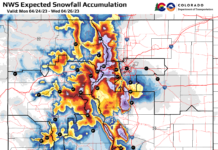by Nina Wood
The past few weeks have not been a particularly good one for deer between Parshall and Kremmling on Highway 40. It seems each day there are more skid marks, followed by a bloody patch on the pavement. Of course, the eagles, ravens, and crows are thick, and no doubt the coyotes are fed as well.
So how was this winter as far as the deer are concerned? Lyle Sidener of Colorado Parks and Wildlife says winter is hard on the wildlife no matter how mild or severe the weather is. But the mule deer population isn’t significantly low or high. They survey those that become roadkill and do a femur marrow fat test on some to check for changes in that which indicate starvation. Tests in fawns have shown only a small negative change.
The strong, warm winds that came through the area three weeks ago took a lot of the snow cover from the south-facing slopes where deer had already gathered to look for food. Those slopes near the roads and the highway through the county mean in many places the deer have to cross to get to water and are thus vulnerable to being hit. Where they come up a steep embankment and jump a guardrail onto the pavement they can so suddenly appear in front of a vehicle it’s next to impossible to avoid them. Slower speeds help, but in one area east of Parshall the speed limit goes from 55 to 65 right at one of the main crossing sites.
As we move into spring and the snow recedes, the deer will move further back away from the roads, but in the meantime extra caution will help to keep the wildlife and the humans safe from each other.









